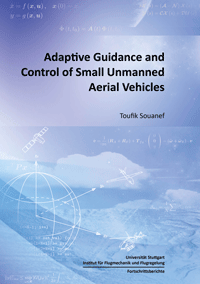
Shop : Details
Shop
Details
45,80 €ISBN 978-3-8440-7042-2Paperback144 Seiten55 Abbildungen212 g21 x 14,8 cmEnglischDissertation
November 2019
Toufik Souanef
Adaptive Guidance and Control of Small Unmanned Aerial Vehicles
This dissertation focuses on adaptive guidance and control of small fixed-wing Unmanned Aerial Vehicles (UAVs). Small UAVs are very sensitive to wind. Furthermore, they are generally built with low-cost material which makes them prone to frequent faults and failures. On the other hand, limited avionic equipment reduce the possibility to elaborate and implement complicated guidance and control systems. All these reasons motivate the use of a control method that is robust to faults and disturbances and relatively simple for implementation, namely L1 adaptive control.
First, an approach for L1 adaptive control is presented based on an adaptation law that borrows insights from the sliding mode control to estimate the unknown bounds of disturbances. Next, an approach of path-following for fixed-wing UAVs is developed considering the presence of wind disturbances. The key idea is to formulate the path-following of a fixed-wing UAV as a control problem in the presence of parametric uncertainties and external disturbances.
Another contribution of this dissertation is the development of a method for fault tolerant control. The design is based on an L1 adaptive controller with a nominal reference model and a set of degraded reference models. In a degraded model the criteria of performance are reduced.
Towards real flight tests, an approach for output feedback L1 adaptive control was designed. The main motivation is that the measure of the full state is not available on small UAVs. The proposed method is based on a state observer instead of the state predictor characteristic of L1 adaptive control. The main advantage is that a full state measurement can be avoided, and the design and the implementation of the controller are simplified.
First, an approach for L1 adaptive control is presented based on an adaptation law that borrows insights from the sliding mode control to estimate the unknown bounds of disturbances. Next, an approach of path-following for fixed-wing UAVs is developed considering the presence of wind disturbances. The key idea is to formulate the path-following of a fixed-wing UAV as a control problem in the presence of parametric uncertainties and external disturbances.
Another contribution of this dissertation is the development of a method for fault tolerant control. The design is based on an L1 adaptive controller with a nominal reference model and a set of degraded reference models. In a degraded model the criteria of performance are reduced.
Towards real flight tests, an approach for output feedback L1 adaptive control was designed. The main motivation is that the measure of the full state is not available on small UAVs. The proposed method is based on a state observer instead of the state predictor characteristic of L1 adaptive control. The main advantage is that a full state measurement can be avoided, and the design and the implementation of the controller are simplified.
Schlagwörter: Adaptive Control; UAV; Path-following; Fault-tolerant Control
Fortschrittsberichte des Instituts für Flugmechanik und Flugregelung
Herausgegeben von Univ.-Prof. Dr.-Ing. Walter Fichter, Stuttgart
Band 9
Verfügbare Online-Dokumente zu diesem Titel
Sie benötigen den Adobe Reader, um diese Dateien ansehen zu können. Hier erhalten Sie eine kleine Hilfe und Informationen, zum Download der PDF-Dateien.
Bitte beachten Sie, dass die Online-Dokumente nicht ausdruckbar und nicht editierbar sind.
Bitte beachten Sie auch weitere Informationen unter: Hilfe und Informationen.
Bitte beachten Sie auch weitere Informationen unter: Hilfe und Informationen.
| Dokument |  | Gesamtdokument | ||
| Dateiart |  | |||
| Kosten |  | 34,35 € | ||
| Aktion |  | Zahlungspflichtig kaufen und anzeigen der Datei | ||
| Aktion |  | Zahlungspflichtig kaufen und download der Datei | ||
| Dokument |  | Inhaltsverzeichnis | ||
| Dateiart |  | |||
| Kosten |  | frei | ||
| Aktion |  | Anzeigen der Datei | ||
| Aktion |  | Download der Datei | ||
Benutzereinstellungen für registrierte Online-Kunden (Online-Dokumente)
Sie können hier Ihre Adressdaten ändern sowie bereits georderte Dokumente erneut aufrufen.
Benutzer
Nicht angemeldet
Export bibliographischer Daten
Shaker Verlag GmbHAm Langen Graben 15a52353 Düren
Mo. - Do. 8:00 Uhr bis 16:00 UhrFr. 8:00 Uhr bis 15:00 Uhr
Kontaktieren Sie uns. Wir helfen Ihnen gerne weiter.



